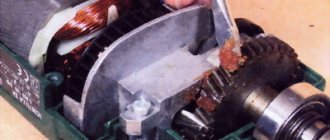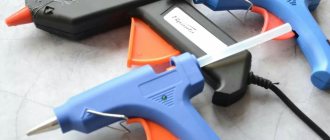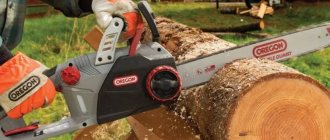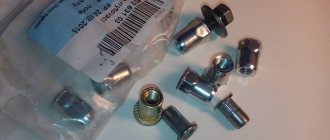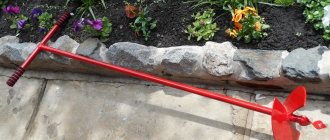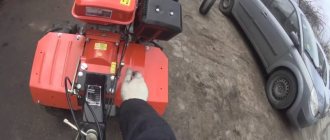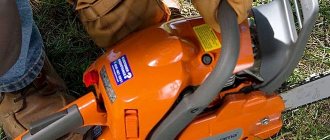A caulk gun is used not only for interior repairs, but also for some exterior work in home construction. This tool got its name because of the peculiarities of its action. The sealant comes out when the trigger is pulled, which is why the tool is compared to this firearm. But this comparison, of course, is conditional, since the composition is squeezed out by a piston, which moves after the trigger is pulled. Therefore, it is more of a syringe.
How to use a caulk gun in pictures
- 1 Operating principle 1.1 Video - how to use a sealant gun
- 2.1 Video - Sealant application technology
- 5.1 Video - Using acrylic sealant
Types of sealant guns
They produce reinforced, skeletal, semi-hull, cylindrical models.
Features of the species:
- The skeletal one is made of steel 1.5 mm thick or high-strength plastic, the rod is made of a hexagonal, circular cross-section with a diameter of 6 mm. Frame support bars ensure smooth movement of the rod and hold the tube.
- The reinforced version does not differ in design from the previous pistol, but the thickness of the metal is increased to two millimeters, and the rod is made with a cross-section of 8 mm.
- Semi-cropped is characterized by short duration of work and low cost. The design uses parts with a thickness of 1 mm, the body is made in the form of half a cylinder. During operation, the rod sometimes warps and may jump off.
- The cylindrical case model is considered a universal option, since the sealant can be used in tubes, soft sausage packaging, or without any container at all.
Mechanical
Mechanical pistol
A practical pistol is used more often in everyday life. A tube is placed in the gun, the composition is squeezed out of it by periodically pressing the trigger.
Description:
- the syringe gun comes with a rotating or fixed body, versions with a closed shell are excluded;
- the rotary version involves rotating the holding part to work at different angles;
- There are prototypes with a counterweight, in which the force on the hand is distributed evenly due to the handle being offset to the center.
To advance the rod, the user applies muscle force. The mechanism is reliable and simple. The maneuverable and compact device can adjust the feed rate.
Pneumatic
Expensive pistols are used in everyday life and for industrial use. The sealant and glue are applied in an even layer, the work progresses quickly.
Description of the air gun:
- used for significant volumes;
- the tool is connected to a pneumatic line with the required technical characteristics; a mobile compressor can be used;
- A muffler is installed on the unit, the tool operates silently;
- the gun weighs little and has good performance;
- The amount of pneumatic pressure and the output speed are adjusted by the regulator.
Pneumatic models are inexpensive compared to electric guns, but the price is higher than mechanical ones. The supply of sealant does not require muscular effort; the work occurs when the trigger is lightly pressed.
Rechargeable
Used for various volumes of seam sealing, gluing, and sealing. The tool allows intensive use on large construction sites. Outwardly it looks like a combination of a cordless screwdriver and a semi-closed or open sealant gun.
Description of the tool:
- provides feed adjustment and uniform application;
- the high cost is due to the built-in electric motor, the possibility of using autonomous batteries and a charger;
- Works on one charge for up to three hours of continuous application.
The advantage is that with high productivity, no connection to electricity or pneumatic equipment is required; you can work in the field.
The disadvantage is the heaviness of the body.
Electric
A pistol of this type has one drawback - its range of use depends on the length of the carry. The user presses the trigger, and the piston is moved by an electric motor.
features :
- Constantly high productivity;
- it is possible to coordinate the flow rate by reducing or increasing the feed rate;
- compared to the battery version, it weighs little;
- There are different models with additional useful features;
- the cost is lower than a battery pistol.
The devices have a stop-drop system to immediately stop squeezing out the composition. The sealant can be changed quickly and easily due to the new locking design. The material is fiberglass plastic, which increases reliability and durability. When you stop working, there is a stand for storing tools.
Types of packaging of sealing composition
The liquid composition can be packaged in different ways, so to understand the principle of operation and how to load a gun, you need to understand the differences between the types. So there is sealant in cartridges and in a foil tube.
The liquid composition can be packaged in different ways.
Cartridge
Made from plastic or cardboard material. The fixation is rigid. It is a horse-drawn horse with a tip. The bottom of the package is movable and changes its location when the piston is pressed. Suitable for skeletonized and semi-open appliances. Sold in small volumes, up to 300 ml.
Suitable for skeletonized and semi-open appliances.
Foil tube
The silicone composition is similar in shape to sausage. The foil material does not differ completely, and the shape of the sealant does not hold. This determines their use in closed types of devices, the design is soft. The amount of composition placed in the tube can range from 250 to 600 ml. The cost of this type is lower than the previous one.
The amount of composition placed in the tube can range from 250 to 600 ml.
Recommendations for choosing a quality pistol
Gun for two-component sealant
Expensive battery-powered, pneumatic and electric options are used on large objects. For home repairs, restoration of furniture or surfaces, purchase a mechanical model.
Tool selection rules:
- for home use, choose a case that supports the installation of small containers of 280, 310 ml, ideally taking into account the installation of soft packaging;
- inexpensive models are used for one-time work , and a home craftsman should have a reinforced version in his arsenal;
- if the sealant is two-component , without packaging, you need a self-priming prototype.
Pay attention to the weight and ease of placement in the hand.
How to use a caulk gun
The mechanical devices are simple, so there are no problems with use, just read the instructions.
Additional items are prepared for work
- Spatula for forming a seam, leveling, cutting off residues. It is purchased one at a time for the selected seam option, or you can buy a set at once.
- A container with a diluted soap solution for treating the spatula and the surface around the future seam. The soap solution prevents the sealant from sticking.
- Paper tape (painting tape) . Used for sealing boundary planes so as not to stain them with glue or sealant.
For ease of cleaning, use rags and foam sponges.
How to insert sealant
Prepare the tube by cutting off the nose of the tip, the cut is made at an angle of 45° . The feed tube is cone-shaped, so the hole is chosen so that the feed speed matches the width of the seam. It is better to first cut off a small tip, try the output, then increase it if necessary. is made on the tube itself at the place where the tube is screwed on .
Installation Features:
- The sealant in a plastic tube is placed in a tubular or skeletal-type gun.
- The fixing plate is loosened, the rod with the piston is pulled back until it stops.
- A plastic cartridge is placed in the vacated gap.
- The rod with a round nozzle is brought to the bottom of the tube until it stops.
After this, open the cap on the spout of the cartridge, press the trigger several times so that the mixture comes out of the tube into the tube.
How to squeeze out the composition
The application surface is cleaned of dust and dirt. Glue and sealant do not adhere well to wet materials, so assembly seams must be dried.
The mixture is squeezed out when the trigger is pulled rhythmically. The pressure is distributed evenly so that the sealant comes out of the tube continuously. The tube is positioned at an angle of 45°.
If it is necessary to stop the supply of sealant, loosen the fixing plate. The composition will continue to come out for some time if this is not done. There is no need to remove the piston rod - this will not affect the mixture output.
How to replace sealant
To replace, loosen the fixing plate, then pull the rod with the piston back until it stops (pull it out manually). In this position, the cartridge will no longer be held in the barrel, so getting it out will not be difficult.
You need to charge a new cartridge according to the old principle with preparing the tube, puncturing the exit point and trimming the spout.
How to clean a gun
The design of the mechanical tool is designed so that the sealant does not come into direct contact with the parts of the device. There is no need to clean the gun of sealant. As part of regular maintenance, it is recommended to lubricate rubbing parts to increase their service life.
For self-priming guns that work with sealants without packaging, there are special washes sold in the store. They are connected like a suction tube and the body is washed.
Device and characteristics
Structurally, the sealant gun consists of the following parts:
- The body (frame) into which the tube is inserted.
- Rod with piston - depending on the type of gun, it can be hexagonal, smooth or serrated. Its purpose is to push the mass from the tube to its spout.
- A handle with a trigger, when pressed, the sealant is pressed out in portions with a piston.
- A fuse to keep the piston from spontaneous reverse motion and fix it at a given level.
Also included with the tool are various attachments that allow you to set the characteristics of the seam being applied.
So there are nozzles that are convenient to quickly apply and level the material at the same time, for example, on joints in the bathroom.
Material
In the manufacture of sealant guns, depending on their type, durable plastic that is resistant to mechanical stress or steel coated with anti-corrosion paint is most often used.
They can also use tool steel, which contains chromium and vanadium or aluminum.
The latter is used in the production of only cabinet models, regardless of the method of actuating their mechanism.
Dimensions and weight
The vast majority of sealant guns are made to fit the corresponding sizes of standard tubes with a capacity of 310 and 600 ml.
The length of the simplest tool is approximately 220 mm and 440 mm, respectively.
In principle, the dimensions of the gun do not matter much and are marked according to the standards of the cartridges for which they are intended to work.
The instrument weighs on average from 250 g.
Additional functions
Modern tools can be equipped with various additional functions to make work easier, including:
- Illumination of the sealant application area.
- Trigger lock for easy long-term operation.
- Adjustable speed of sealant application, which improves the accuracy of work
- Leakage protection.
Among other things, for the sealant gun you can additionally purchase all kinds of backlit attachments, a cleaning needle, and a punch that allows you to remove the hardened mixture.
The nozzles themselves, by the way, can have very different shapes, allowing you to apply sealant to hard-to-reach places.
Recommendations from experts
It is better to buy models from trusted manufacturers and brands that produce good quality tools.
Other tips:
- masking tape on adjacent surfaces is removed after the composition has completely dried;
- It is better to use gloves when working;
- unexpected drops of sealant or glue on a hard surface are removed mechanically or dissolved with white spirit, gasoline, or a professional cleaner (depending on the type of composition).
The gun is stored in rooms with normal humidity so that the paint layer does not deteriorate and corrosion does not develop on the parts.

